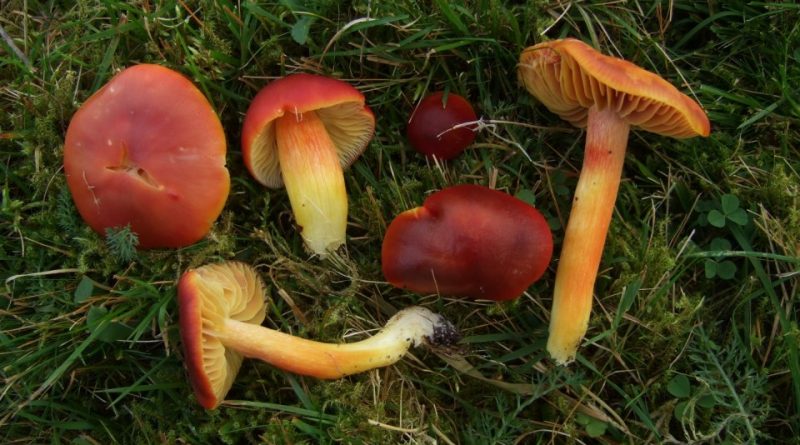Hygrocybe punicea
Hygrocybe punicea
The punicean Hygrophore (Hygrocybe punicea (Fr.) P. Kumm., 1871) is a basidiomycete mushroom belonging to the Hygrophoraceae family.
Systematic –
From the systematic point of view it belongs to the Domain Eukaryota, Kingdom Fungi, Basidiomycota Division, Class Basidiomycetes, Order Agaricales, Family Hygrophoraceae and therefore to the Genus Hygrocybe and to the Specie H. punicea.
The terms are more common: Agaricus puniceus Fr. and Hygrophorus puniceus (Fr.) Fr.
Etymology –
The term Hygrocybe comes from the Greek ὐγρός hygrόs, wet and from κύβη cýbe, head, hat: that is, with the wet hat. The specific punicea epithet is somewhat controversial; it derives from the Greek φοινίκιος phoiníkios pertaining to the Phoenicians (or Punic, Carthaginians), population that traded the purple, or purple-red, from φοῖνιξ phóinix purple scarlet: bright red or reference to the area of origin (current Tunisia).
Geographic Distribution and Habitat –
The Hygrocybe punicea grows in the meadows and mountain pastures and on the mountain moors, in the period between late summer and autumn.
Recognition –
The Puniceo Hygrophore is recognized for the hat, of 3-10 cm of diameter, which is irregularly campanulate and then convex, often lobed at the margin, of viscous and fragile consistency; the color is blood red, which then turns orange red. The lamellae are attached to the stem, wide, thick; yellowish, then with reddish shades. The stem is 8-15 cm long and 8-20 mm thick and is hollow, fibrous-striated, cylindrical and pointed at the base, yellow with intense shades and red streaks, which becomes yellowish towards the foot. The flesh has a soft consistency, white in the stem, color or yellow under the cuticle, with a pleasant and unattractive smell and taste. The microscope shows cylindrical-elliptic spores, white in mass of 9-10 x 5-6 μm. Basidia are tetrasporic.
Cultivation –
The Hygrocybe punicea is not a cultivated mushroom.
Uses and Traditions –
The Hygrocybe punicea is a fungus that can face a decline in presences both for the indiscriminate collection and for the pollution, especially that produced by fertilization.
This fungus can be exchanged with H. aurantiosplendens, which, however, has smaller dimensions, with a 2.5-5 cm cap, lighter, orange and with red umbo; another distinctive element from H. punicea, is represented by the slimmer stem, which measures 3.5-7 × 0.5-1.5 cm, lighter and with yellow-orange and never red fibrils; it is very buried in the mountain meadows, it is rather rare and, for this reason, it must be respected. Another mushroom with which it can be exchanged is H. splendidissima, which has a 3-7 cm cap, has an acute umbone, reddish-orange-carmine color and less wide lamellae than in H. punicea, yellow-orange color; the stem has yellow but white flesh at the base, is shiny, lardaceous, grooved, hollow, concolour to the cap and with yellow and white tones at the base; the taste is as grateful as the smell, which has a honeyed scent with drying. Finally, also with H. coccinea, of small size, which has a cap of 1.5-5 cm, sub-hemispheric, glabrous, dry and never viscous as in H. punicea, having a red-cherry color that lightens more towards the disc; yellow lamellas then orange, with yellow thread; hollow stem, 3-8 × 0.5-0.8 cm, colorless to the top hat and then gradually faded to the base white; habitual habitat, in the damp moss of the clearings; meat odorless and tasteless, but pleasant.
It is probably the red-colored Hygrocybe of bigger size. It is a good edible fungus but of poor yield. Its collection, however, should be discouraged for the less experienced, due to its distant resemblance to some poisonous species of the genus Cortinarius and Inocybe; however, it is distinguished by the yellow-orange color of the lamellae and the stem. The Puniceo Hygrophore, in optimal climatic conditions, can well exceed the average size and consequently a considerable increase in yields; in any case, the consumption of picked mushrooms must be done in a short time as it has a meat easily perishable and therefore it is advised not to consume specimens too old.
Preparation Mode –
Hygrocybe, in general, are mushrooms that are sought after for their delicacy and excellence in the kitchen; some recipes with which they are prepared are: creamed with chanterelles, punicea and cesarea, risotto with Punicea and pomegranate, tagliatelle with Punicea sauce or the patty stuffed with hygrophors with goat cheese sauce and yogurt. These are some of the most elaborate and tasty recipes that these particular mushrooms allow in the kitchen.
Guido Bissanti
Sources
– Wikipedia, the free encyclopedia.
– Cetto B., 2008. Real mushrooms, Saturnia, Trento.
– Pignatti S., 1982. Flora d’Italia, Edagricole, Bologna.
– Conti F., Abbate G., Alessandrini A., Blasi C. (edited by), 2005. An annotated checklist of the Italian vascular flora, Palombi Editore.
Warning: Pharmaceutical applications and alimurgical uses are indicated for informational purposes only and do not in any way represent a medical prescription; there is therefore no liability for their use for curative, aesthetic or food purposes.


